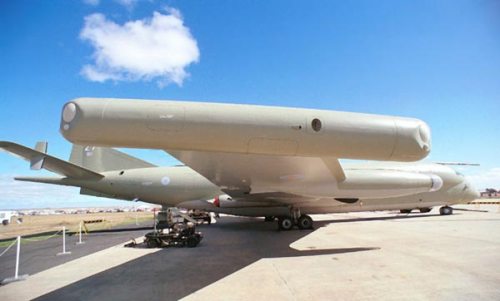
USS KITTY HAWK (CV 63), At Sea (November 9, 2005) Aviation Ordnanceman prepare to load a CATM-88 Harm missile onboard the USS Kitty Hawk (CV-63). While at sea, Kitty Hawk and Carrier Strike Group 5 will be participating in an annual exercise with the Japanese Maritime Self Defense Force. Currently underway in the western Pacific Ocean, Kitty Hawk Carrier Strike Group demonstrates power projection and sea control as the Navy's only permanently forward-deployed aircraft carrier strike group, operating from Yokosuka, Japan. U.S. Navy photo by Photographers Mate 3rd Class (AW) Jonathan Chandler.
After writing few posts discussing the technological influence on defence stratagies of different nation, this time I thought to go slightly technical. A reader may use this information as an extension of my discussion on Electronic Warfare – Electronic Warfare Operations Warfare has always been conducted by adversaries who have been at great pains to understand their enemy’s strengths and weaknesses in order to minimise the risk to their own forces and territory. The detection and interception of messages and the efforts to deceive the enemy have long been the task of the ‘secret service. As methods of communication developed, so too did methods of interception become more effective. Radar has developed from a mere detection mechanism to a means of surveillance and guidance. This post is focuses on gathering information on immediate threats which is performed by Electronic Support Measures (ECM)

MH-53 Pave Low helicopters prepare to take off for their final combat mission on Sept. 27, 2008, in Iraq. The MH-53, the largest and most technologically advanced helicopter in the Air Force with a record dating back to the Vietnam War, was retired from the Air Force inventory on Sept. 30, 2008
Electronic Warfare (EW) planning requires a broad understanding of enemy and friendly capabilities, tactics, and objectives. Employment of EW assets must be closely integrated into, and supportive of, the commander’s overall planning effort. This planning requires a multidisciplined approach with expertise from operations (ground, airborne, space), intelligence, logistics, weather, and information. Application of this sort of EW planning and employment was seen in Operation Desert Storm in 1991. three US Air Force MH-53J PAVE LOW helicopters (shown above) led nine US Army AH-64 Apache helicopters across the Saudi Arabia-Iraq border to attack two Iraqi early warning radar sites. Taking down these two sites opened the door for attacks across Iraq by F-117s, other coalition aircraft and Tomahawk missiles (shown below).
After the F-117s and cruise missiles came conventional aircraft. From 0355L to 0420L (H+55 to H+1:20) large numbers of USAF, USN, USMC, RSAF, and RAF aircraft smashed Iraqi air defenses and fields from H-3, an airfield located in western Iraq, to Ahmed Al Jaber, an airfield in occupied Kuwait. Two packages of aircraft, one a USN package from the Red Sea carriers and the other a USAF package from the south pointed directly at Baghdad. These “gorilla” packages were intended to seem threatening enough to force the Iraqis to hurl their air resources in defense. Air Force ground-launched BQM-34 and Navy tactical air-launched decoys (TALD) mimicked the radar return of conventional aircraft to further arouse Iraqi radar operators, many already confused by the absence of central control from Kari. Finally, radar-jamming aircraft radiated blanketing electronic emissions that drove the Iraqi radar operators to go to full power in an attempt to break through the interference. Then, the two incoming coalition flights revealed their true nature and pounced in a shrewd and devastating ruse.

The newest upgrade is a joint venture by the Italian Ministry of Defense and the US Department of Defense: the AGM-88E Advanced Anti Radiation Guided Missile (AARGM), produced by Alliant Techsystems.
What was unique here that, instead of bomb-carrying fighter-bombers, they were radar-killing electronic warriors carrying AGM-88 high-speed antiradiation missiles (HARMS) designed to home in on SAM and AAA radar (shown above). The AGM-88 High-speed Anti-Radiation Missile (HARM) is a tactical, air-to-surface missile designed to home in on electronic transmissions coming from surface-to-air radar systems. Originally developed by Texas Instruments (TI) as a replacement for the AGM-45 Shrike and AGM-78 Standard ARM system. Production was later taken over by Raytheon Corporation (RAYCO) when they purchased TI’s defense business. The AGM-88 can detect, attack and destroy a radar antenna or transmitter with minimal aircrew input. The proportional guidance system that homes in on enemy radar emissions has a fixed antenna and seeker head in the missile’s nose. A smokeless, solid-propellant, dual-thrust rocket motor propels the missile at speeds over Mach 2. HARM, a Navy-led program, was initially integrated onto the A-6E, A-7 and F/A-18 and later onto the EA-6B. USAF F-4G Wild Weasels alone expended dozens of HARMS in twenty minutes, while USN/USMC F/A-18s fired one hundred for the night. HARMS filled the air over Baghdad, the site of over one-half of Iraq’s SAM and AAA batteries. Foolishly, the Iraqis did not turn off their radars, even when the HARMS fireballed in their midst; as one USAF flight leader averred, ‘the emitters came on and stayed on for the entire flight of the missiles.’ This deadly surprise not only destroyed many Iraqi radars, it also terrified their operators. For the rest of the war, they showed great reluctance to use radar and often chose to launch their SAMs with optical or even no guidance.
High-speed Anti-Radiation Missile (HARM) – A Little Overview
The initial HARM attack and the F-117 bombings of the Kari system left Iraq’s integrated air defense system shattered, opening up the country so completely that, within days, coalition air-to-air tankers regularly operated in Iraqi airspace. Other non-stealthy aircraft pummeled Iraqi airfields. An anti-radiation missile (ARM) is a missile which is designed to detect and home in on an enemy radio emission source. Typically these are designed for use against an enemy radar, although jammers and even radios used for communication can also be targeted in this manner. This sort of weapons are key to EW inventory. The word “Radiation” here refers to Electromegnetic radiation, not nuclear. The missile is the direct descendant of the Shrike and Standard ARM missiles used in Vietnam. Most ARM designs to date have been intended for use against ground-based radars. Commonly carried by specialist aircraft in the SEAD (Suppression of Enemy Air Defense) role (known to the USAF as “Wild Weasels”), the primary purpose of this type of missile is to degrade enemy air defenses in the first period of a conflict in order to increase the chances of survival for the following waves of strike aircraft. They can also be used to quickly shut down unexpected SAM sites during a raid. Aircraft which fly with strike aircraft to protect them from enemy air defences often also carry cluster bombs and are known as a SEAD escort. The cluster bombs can be used to ensure that after the ARM disables the SAM system’s radar, the command post, missile launchers, and other components or equipment are also destroyed to guarantee the SAM site stays down.

The R-27 is manufactured in infrared-homing (R-27T), semi-active-radar-homing (R-27R), and active-radar-homing (R-27AE) versions, in both Russia and the Ukraine. The R-27 missile is carried by the Mikoyan MiG-29 and Sukhoi Su-27 fighters, and some of the later-model MiG-23MLD fighters have also been adapted to carry it.
The above account of the First Night of Operation Desert Storm was taken from the Decisive Force: Strategic Bombing in the Gulf War by Richard G. Davis. More recently, air-to-air ARM designs have begun to appear, notably the Russian Vympel R-27P. Such missiles have several advantages over other missile guidance techniques; they do not trigger radar warning receivers (conferring a measure of surprise), and they can have a longer range (since battery life of the seeker head is the limiting factor on the range of most active radar homing systems).
Electronic Support Measures
Technically ESM consists of a collection of senstive antennas designed to detect signals in different frequency bands. Often these antennas are grouped at aircraft’s wing tip pod, which allows a wide angle view without causing too much obstruction as well as to enable a fix on the signal source to obtain an accurate Dircection of Arrival (DoA) of the signal. An effective ESM system rapidly identifies the signal band and location, and determines the signal characteristics. A signal analyser then examines the signal characteristics to identify the type of transmitter and the level of threat posed. Even the most cursory of analysis can establish whether the emitter is associated with surveillance, target tracking or target engagement. This analysis can compare the signal with known emitter characteristics obtained from an intelligence database or threat library and known signal types confirmed and new emissions identified and categorised. Every signal identification is logged with date, time and intercept coordinates, along with the known or suspected platform type, and the results are stored.
Signals received by the electronic support measures system may in some cases be analysed instantaneously to produce an identity for the transmitter of each signal received. Pulse width, Pulse amplitude and carrier frequency are few important parameters. The nature of the pulse shape is used to determine the particular type of transmitter. The scan rate and the pattern of the scan also provide invaluable information about the mode of the transmitter. It is possible to detect the antennas changing from scanning mode to lock-on to tracking and hence determine the threat that the transmitting station poses. As well as providing threat information, ESM is used by maritime and battlefield surveillance aircraft as a passive or listening sensor which adds important information to other sensors.
The salient signal characteristics or discriminators identified during the ESM collection and identification process includes: Signal Frequency (this is to detect the radar type), Blip/Scan ratio (to get the estimate for scan rate, sector scan width and radar bandwidth), Scan Rate, Scan Pattern (Search, track, track-while-scan (TWS) and ground-mapping (GM) modes will exhibit particular characteristics), Signal Modulation (Pulse, pulse compression, pulsed Doppler (PD), a continuous wave (CW) and other more sophisticated forms of modulation are indicative of the emitter mode(s) of operation and likely threat level) and finally Pulse Repetition Frequency (PRF).
Technical details as well as the schemetic of the ESM system can found in any dedicated military systems book, however, those who are Interested to explore more, I will strongly recommend Military Avionics Systems by Ion Mior and Allen Seabridge.
The combination of analysis of all these modes of operation and when they are employed either singly or in combination is vital to establishing the likely capabilities and intentions of a threat platform, especially when used in combination with other intelligence information. Electronic Support Measures may be employed at a strategic intelligence-gathering level using an AWACS (airborne early warning and command system) or MPA aircraft to build the overall intelligence picture and electronic order of battle (EOB). Alternatively, such information may be gathered and utilised at a tactical level using radar warning receivers (RWR), whereby information is gathered and used at the strike platform level to enable strike aircraft to avoid the most heavily defended enemy complexes during the mission.
As I mentioned earlier, this (ESM) is one element of Electronic Warfare. This is because the nature of EW warfare and devices used. The operating frequency ranges for radars are usually very broad, and no single system can cover the whole range for transmission or reception. Hence, most communications and radar systems are designed for use in specific bands. These bands are usually designated by international convention. The main role of electronic warfare is to search these radio-frequency bands in order to gather information that can be used by intelligence analysts or by front-line operators. The information gained may be put to immediate effect to gain a tactical advantage on the battlefield; it may be used to picture the strategic scenario in peace time, in transition to war, or during a conflict. It may also be used to devise countermeasures to avoid a direct threat or to deny communications to an enemy. It must also be observed that such tactics are deployed by all sides in a conflict – in other words, the listeners are themselves being listened to.












